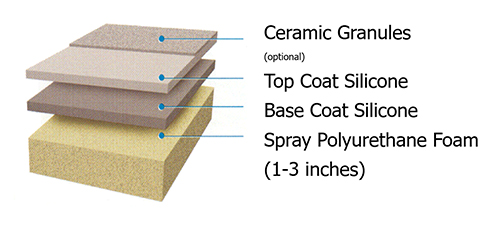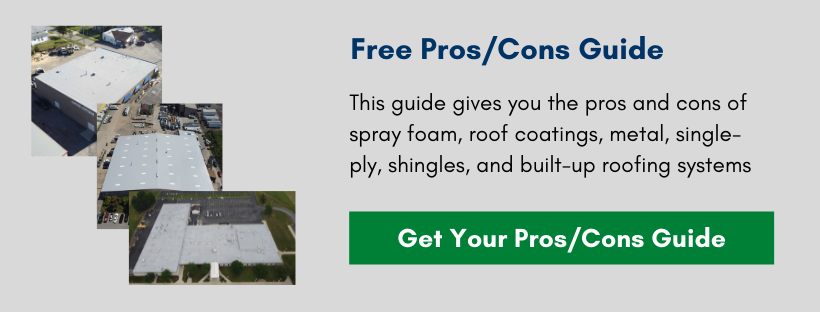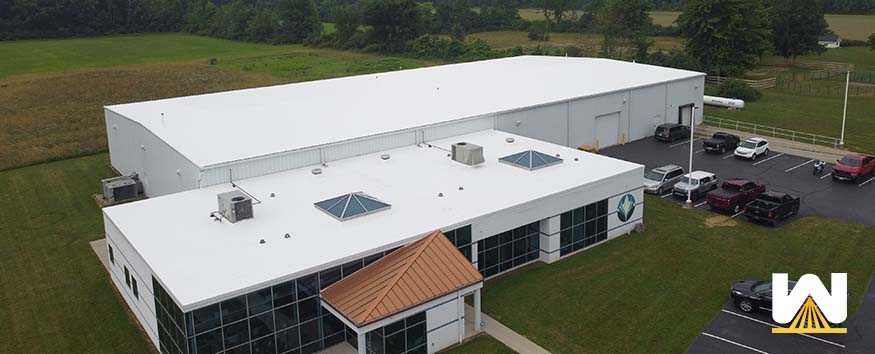The core values of a commercial roof are:
- To not leak
- To not negatively affect the bottom line
- To be energy-efficient
If any of these are happening on your roof, it may be time to think differently about a solution.
Let’s dive into each of these below.
And just so you know, West Roofing Systems has been in commercial roofing since 1979. We’ve seen companies that operate while setting up 55-gallon buckets to collect water. We’ve seen money go right through a roof because of bad installations or in-efficient insulation. And we’ve also seen roofs that need constant maintenance and ones that pay for the costly complete tear-off, which greatly affects a company’s bottom line.
Every article written by West Roofing Systems is edited by a commercial roofing professional with more than 30 years of experience.
Let’s get started!
Core Value #1 – To not leak
The #1 goal of a commercial roof is to not leak. Leaking can damage your assets, be a distraction for employees, create a safety hazard, and interrupt business.
There are several reasons why a roof is leaking, such as:
- The roof is worn out (aka it’s just really old!)
- The roof was installed incorrectly and didn’t last as long as it was designed to
- The seams pulled apart and are now allowing water into the insulation
- The membrane on the flashings and penetrations has lost adhesion
- Some pinholes or cracks are allowing water into the roof system
- Drains are clogged and water has nowhere to go but into your building
The list goes on and on. If you have a roof leak, contact a roofing contractor immediately. Not only can you get the leaking to stop, but as more water saturates the insulation and comes into the building, the more costly a repair will be.
Stop the bleeding! Make the call.
I wanted to point out that ALL roofing systems can leak. And ALL roofing systems can perform leak-free when installed correctly.
However, there are some advantages of the spray polyurethane foam roofing system when it comes to leaking.
Spray foam is closed-cell. This means if there’s a puncture or crack in a foam roof, the water will sit there and not move.
This is the reverse of all other roofing systems that have traditional open-cell insulation. When water enters open-cell insulation, the water can travel, saturating more and more of the insulation until it enters your building.
This is similar to using an eyedropper to drop water into the corner of a paper towel. Eventually, the entire paper towel is soaked, even though you only dropped water into the corner.
The same can happen for traditional, open-cell insulation where water is only entering through a tiny opening, but the entire sheet of insulation will be soaked.
Spray foam roofs are fluid-applied, so they don’t have any seams or fasteners, which are the leading causes of roof leaks. Eliminating these variables can greatly reduce the likelihood of a roof leak.
Core value #2 – To not negatively affect the bottom line
Money’s everything…right?
While most people put great emphasis on initial costs, the wise consider lifetime costs when making decisions.
I wanted to talk about roof renewability and the ease of repairs.
Roof renewability
What happens to most roofs when they reach the end of their warranties? They are usually 100% ripped off, transported to a landfill, and a new roofing system is installed.
Most don’t know about a spray foam roof’s ability to be renewed.
A spray foam roof has four parts:

If you would get a 20-year-warranty for your spray foam roof, 30 mils of coating would be installed to protect the foam roof from UV rays.
When the 20 years are up, the 30 mils may have worn down to 7-8 mils.
A roofing contractor can clean the roof and bring the level of coating back to 30 mils. A new 20-year-warranty would be granted. The spray foam doesn’t lose any insulating performance over time.
To recoat a spray foam roof costs 1/3 to ½ of the initial installation.
A complete tear-off and installation of any roofing system will cost 100% (if not more due to inflation) of the initial installation.
Ease of repair
On a spray foam roof, since it’s closed-cell and the water will sit in the puncture and not move, a contractor can dry the area, cut around the puncture, add in caulk or coating, smooth the area out, and the repair is done.
On traditional roofs, as explained before, water can enter through a small area and saturate a large section of insulation. You would have to peel back the membrane and determine how far the water traveled. Then you’d have to install a new insulation board and a new membrane. And then make sure the membrane is fastened to the other sheets of the membrane.
When looking at future costs, the ease of repair should be considered. How often do you want a repair guy on the roof? And how long do you want them there?
Core value #3 – To be energy-efficient
Why throw money out of the window (I mean, threw the roof!)
Heating and cooling costs are only going to increase. And to limit energy resources, the minimum R-value for roofing is only to increase.
If you’re unfamiliar, R-value is a material’s ability to restrict airflow. The higher the R-value, the less air that can pass through it.
A roof with an R-30 will rely on an HVAC unit much less than a roof with an R-10. This is important when trying to reduce energy costs.
While traditional roofs can increase R-value by adding insulation boards, they would still need to remove the top membrane to install the boards. It would take a lot of labor to do this.
Another option is to install a spray foam roof.
Spray foam is fluid-applied so it can be installed right over your existing roof. Spray foam also has the highest R-value per inch of thickness, an R-6.5.
Depending on the current conditions of your roof, a spray foam roof can have a buyback period.
Buyback period?
If the roof is leaking and isn’t energy efficient, your energy costs are going to be super high because the HVAC unit is running all day long.
For a simple example, say your energy costs are $1000 per month. After you install a spray foam roof, your new energy cost is $700 per month.
You’re saving $300 per month. How many months will it take to cover the cost of the installation?
Sometimes this is 10 years, sometimes it’s more or less.
For Texas A&M University, it was 4.5 years.
Conclusion
I know we talked a lot about the advantages of a spray foam roof, but I wanted to be clear that any roofing system will work just fine if it’s installed correctly.
If you would like to compare the most popular roofing systems out there today, please consider downloading our eBook below.


